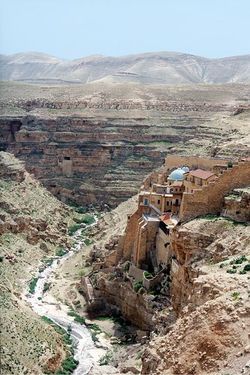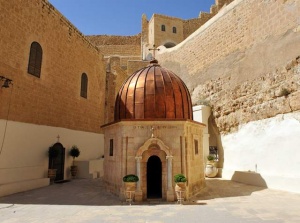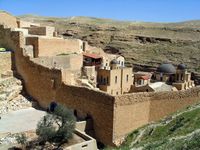Holy Lavra of St. Savas (Jerusalem)
The Holy Lavra of St. Savas (Jerusalem), also St. Sabas and Mar Saba, was founded by St. Savas in 478 as an anchorite colony of monks. It is located in the Kidron Gorge (Wadi en-Nar) near Jerusalem. The monastery influenced greatly the development of the Orthodox church services and typikon. The monastery in ancient times was known as the Great Lavra.
Contents
History
In the fifth century, St. Savas’ Monastery developed around the cell of St. Savas in the cliffs of the Kidron Gorge near Jerusalem as an assemblage of anchorite monks settled near in him in similar cave-like cells. These monks came looking for his spiritual leadership. Initially, they built cells, as had St. Savas, in caves along two kilometers of cliffs around the present day monastery. Many of these cells developed into multi-chambered dwellings and included prayer niches and chapels. During archaeological surveys in the latter twentieth century some forty-five of these hermitages of the Lavra have been examined and preserved. In time two churches were built on the floor of the ravine to serve the community.
Today, the monastery complex consists of two churches, with the tomb of St. Savas in a courtyard between them, and a number of chapels, a common dining room, kitchen, storerooms, cisterns, dwelling cells for the monks, and a hostel for visitors. On the feast day of St. Savas, December 5, the hostel is often filled with upwards of two hundred pilgrims.
The central church is dedicated to the Theotokos, St. Mary. A second church, originally called Theoktistos, built into a cave, is now dedicated to St. Nicholas. The chapels are:
- The Chapel of Ss Joachim and Anna, the parents of the Theotokos.
- The Chapel of St John Chrysostom.
These chapels were built in chambers that had been dwellings of monks.
- The Chapel of St. John of Damascus, which is also dedicated to St. John the Baptist.
This chapel is located in the cave hermitage where St. John of Damascus lived during the early eighth century.
- The Chapel of St. George.
- The Chapel of the Archangels.
The Chapel of the Archangels is of recent origin, having been built by an abbot, Archimandrite Seraphim, during the middle of the twentieth century.
Typikon
As St. Savas’ monastery of hermitages grew, a need was recognized for organizing the religious services of the community. Within the community, practices and customs used by the monastic communities in Palestine, Egypt, and Anatolia, as well as the cathedral services in Jerusalem, were assembled into the Typikon of the ‘‘Church Service of the Holy Lavra at Jerusalem of our God-bearing Father St. Savas’’.
This original Typikon of St. Sava quickly became a reference for monastic services in the Orthodox Church. It was expanded during the seventh and eighth centuries and later synthesized with Palestinian and Constantinopolitan usages. The revised Typikon of St. Savas was widely adopted and, by the fifteenth century, had replaced the typikons of the Cathedral Office and the Studion Monastery of Constantinople. In 1545, it became the first printed typikon.
Source
John Patrich. Chapels and Hermitages of St. Sabas’ Monastery. Ancient Churches Revealed. Yoram Tsafrir, ed. Jerusalem: Israel Exploration Society, 1993. (ISBN 965-221-016-1)


